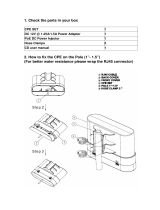
Technical Support
For more troubleshooting help, go to:
www.tp-link.com/support/faq.asp
To download the latest Firmware, Driver, Utility and User Guide, go to:
www.tp-link.com/support/download.asp
For all other technical support, please contact us by using the following
details:
Global
Tel: +86 755 26504400
Service time: 24hrs, 7 days a week
Singapore
Tel: +65 62840493
Service time: 24hrs, 7 days a week
UK
Tel: +44 (0) 845 147 0017
Serv
ice time: 24hrs, 7 days a week
USA/Canada
Toll Free: +1 866 225 8139
Service time: 24hrs, 7 days a week
Malaysia
Tel: 1300 88 875465 (1300
88TPLINK)
Service time: 24hrs, 7 days a week
Switzerland
Tel: +41 (0)848 800998 (German
Service)
Fee: 4-8 Rp/min, depending on rate
of different time
Service time: Monday to Friday
9:00 AM to 6:00 PM
GMT+ 1 or GMT+ 2
(Daylight Saving Time)
Australia & New Zealand
Tel: AU 1300 87 5465
NZ 0800 87 5465
Service time: 24hrs, 7 days a week
Turkey
Tel: 444 19 25DŽTurkish ServiceDž
Service time: 9:00 AM to 6:00 PM
7 days a week
Italy
Tel: +39 02 66987799
Service time: Monday to Friday
9:00 AM to 6:00 PM
Indonesia
Tel: (+62 ) 021 6259 135
Service time : Monday to Friday
9:00 -12:00 ; 13:00 -18:00
*Except public holidays
Germany / Austria
Tel: +49 1805 875465 (German Service) /
+49 1805 TPLINK
Fee: 0
.14 EUR/min from the German fixed
phone network and up to 0.42 EUR/min
from mobile phone
Service time: Monday to Friday
9:00 AM to 6:00 PM
GMT+ 1 or GMT+ 2
(Daylight Saving Time in Germany)
*Except bank holidays in Hesse



















